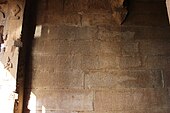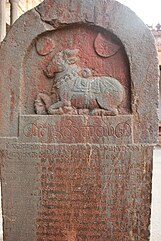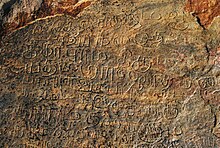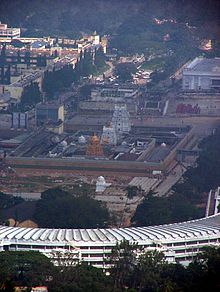Krishnadevaraya
| Krishnadevaraya | |
|---|---|
| Maharaja-dhirāja Kannada Rajya Rama Ramana Andhra Bhoja Dakshinasamudradhiswara Mooru Rayara Ganda Chinna Devi Annapurna Devi | |
| Issue | |
| Dynasty | Tuluva |
| Father | Tuluva Narasa Nayaka |
| Mother | Nagala Devi |
| Religion | Hinduism |

Krishnadevaraya (17 January 1471 — 17 October 1529) was an emperor of the
Krishnadevaraya's rule was characterised by expansion and consolidation. This was the time when the land between the Tungabhadra and Krishna river (the Raichur doab) was acquired (1512), ruler of Odisha were subdued (1514) and severe defeats were inflicted on the Sultan of Bijapur (1520).
When the
Early life
Krishnadevaraya was the son of
Military career
His main enemies were the
Success in Deccan
The raid and plunder of Vijayanagara towns and villages by the Deccan sultans came to an end during the Raya's rule. In 1509, Krishnadevaraya's armies clashed with them and
War with Kalinga
The
Krishnadevaraya planned an invasion of
Krishnadevaraya established friendly relations with the Portuguese in Goa in 1510.[29] The Emperor obtained guns and Arabian horses from the Portuguese merchants.[30][31] He also utilized Portuguese expertise to improve the water supply to the Vijayanagara capital.[32]
Final conflict and death

The complicated alliances of the empire and the five
]The highlight of his conquests occurred on 19 May 1520 where he secured Raichur Fort from Ismail Adil Shah after a difficult siege in which 16,000 Vijayanagara soldiers were killed. The exploits of the military commander, Pemmasani Ramalinga Nayudu of the Pemmasani Nayaks, during the Battle of Raichur were distinguished and lauded by Krishnadevaraya.[35] It is said that 700,000-foot soldiers, 32,600 cavalry, and 550 elephants were used.[36] Portuguese contingent [37] commanded by Cristovão de Figueiredo[38] with the use of fireweapons help to conquer the fortress.
Krishnadevaraya was brutal towards Bahmani Generals of Raichur. Many
Finally, in his last battle, he razed to the ground the fortress of
In 1524, Krishnadevaraya made his son Tirumala Raya the Yuvaraja (crown prince). The prince did not survive for long: he was poisoned.[42] Suspecting Timmarusu, Krishnadevaraya had him blinded.[43] At the same time, Krishnadevaraya was preparing for an attack on Belgaum, which was in the Adil Shah's possession. Around this time, Krishnadevaraya fell ill and eventually died in 1529, succeeded by his brother, Achyuta Deva Raya.[44]
Internal affairs
During his reign he kept strict control over his ministers, and dealt severely with any minister who committed misdeeds.[45] He abolished obnoxious taxes such as the marriage fee.[45] To increase revenues, he brought new lands under cultivation, ordering the deforestation of some areas[45] and undertook a large-scale work to obtain water for irrigation around Vijayanagara.[46][47] Foreign travellers such as Paes, Nunez and Barbosa who visited Vijayanagara spoke highly of the efficiency of his administration and the prosperity of the people during his reign.[45]
The administration of the empire was carried along the lines indicated in his Amuktamalyada. He was of the opinion that the King should always rule with an eye towards Dharma. His concern for the welfare of the people is amply proved by his extensive annual tours all over the empire, during which he studied everything personally and tried to redress the grievances of the people and punish evildoers. With regard to the promotion of the economic progress of his people, Krishnadevaraya says: "the extent of the kingdom is the means for the acquisition of wealth.[48] Therefore even if the land is limited in extent, excavate tanks and canals and increase the prosperity of the poor by leasing him the land for low ari and koru, so that you may obtain wealth as well as religious merit."[48]
Art and literature


Krishnadevaraya was noted to be linguistically neutral as he ruled a multilingual empire. He is known to have patronised poets and issued inscriptions in languages as varied as Kannada, Sanskrit, Telugu and Tamil,. Krishnadevaraya himself was a polyglot, fluent in Kannada Sanskrit, Telugu and Tamil. The official language of the Vijayanagara court was Kannada.[citation needed]
Krishnadevaraya patronized literature in various languages. The rule of Krishnadevaraya was an age of prolific literature in many languages, although it is particularly known as a golden age of Telugu literature. Many Telugu, Kannada, Sanskrit, and Tamil poets enjoyed the patronage of the emperor, who was fluent in many languages,.[49][50] The king himself composed an epic Telugu poem Amuktamalyada. His Sanskrit works include ‘Madalasa Charita’, ‘Satyavadu Parinaya’, ‘Rasamanjari’ and ‘Jambavati Kalyana’.
The Telugu poet Mukku Timmanna praised him as a great general and stated: "O Krishnaraya, you Man-Lion. You destroyed the Turks from far away with just your great name's power. Oh Lord of the elephant king, just from seeing you the multitude of elephants ran away in horror."[8]
Telugu literature

The rule of Krishnadevaraya is known as golden age of Telugu literature. Eight Telugu poets were regarded as eight pillars of his literary assembly and known as Ashtadiggajas. Krishna Dev Raya himself composed an epic Telugu poem Amuktamalyada.[51]
During the reign of Krishnadevaraya Telugu culture and literature flourished and reached their heyday. The great emperor was himself a celebrated poet having composed
- Allasani Peddana is considered to be the greatest and given the title of Andhra Kavita Pitamaha (the father of Telugu poetry). Svarocisha Sambhava or Manucharita, his popular prabandha work, was dedicated to Krishnadevaraya
- Nandi Thimmana wrote Parijathapaharanam
- Madayyagari Mallana wrote Rajasekhara Charitramu
- Dhurjati wrote Kalahasti Mahatyamu
- Ayyalaraju Ramabhadrudu wrote Sakalakatha Sangraha and Ramaabhyudayamu
- Pingali Suranawrote Raghava Pandaviyamu, Kalapurnodayam and Prabhavate Pradyamana
- – Raghavapandaveeyamu is a dual work with double meaning built into the text, describing both the Ramayana and the Mahabharata.
- – Kalapurnodayam ("full bloom of art") has been considered the first original poetic novel in Telugu literature
- Battumurthy, alias Ramarajabhushanudu, wrote Kavyalankarasangrahamu, Vasucharitra, Narasabhupaliyam and Harischandranalopakhyanamu, a dual work which tells simultaneously the story of King Harishchandra and Nala and Damayanti
- Shaivite work. However, he later converted to Vaishnavism and wrote the Vaishnava devotional texts Panduranga Mahatmyamu, and Ghatikachala Mahatmyamu. Tenali Ramaremains one of the most popular folk figures in India today, a quick-witted courtier ready even to outwit the all-powerful emperor.
Other well-known poets were Sankusala Nrisimha Kavi, who wrote Kavikarna Rasayana,
Kannada literature
He patronised several Kannada poets. Among them Mallanarya, who wrote Veera-shaivamruta, Bhava-chinta-ratna and Satyendra Chola-kathe; Chatu Vittalanatha who wrote Bhagavatha and Timmanna Kavi wrote a eulogy of his king in Krishna Raya Bharata. The record highlights the contemporary society during Krishnadevaraya's time in his personal diary. However, it is not yet clear if the record was written by the king himself.
Purandara Dasa, "widely considered the father of Carnatic music" was closely associated with the empire. He extolled the Madhwa philosophy in his compositions and was a disciple of the Rajaguru of the emperor. According to Sambamoorthy,[57] he was born as Srinivasa and had his formal initiation by Vyasatirtha took place around 1525 when he was about 40 years of age, when he was given the name Purandara Dasa. Purandara Daasa traveled extensively in southern India composing and rendering them in praise of his god Purandara Vittala. He spent his last years in Hampi where he rendered his compositions in Krishnadevaraya's court.
Tamil literature

Krishnadevaraya patronised the Tamil poet Haridasa, and Tamil literature soon began to flourish as the years passed by.[58]
Sanskrit literature
In Sanskrit, Vyasatirtha wrote Bhedojjivana, Tatparyachandrika, Nyayamrita (a work directed against the Advaita philosophy) and Tarkatandava. Krishnadevaraya, himself an accomplished scholar, wrote Madalasa Charita, Satyavadu Parinaya and Rasamanjari and Jambavati Kalyana.[53][59][60]
Religion and culture

Krishnadevaraya respected all sects of
Sri Vaishnavas claim that Krishnadevaraya himself was formally initiated into the Sri Vaishnava tradition and that's why he wrote a Telugu work on Andal, a Tamil Sri Vaishnava female saint, called the Amuktamalyada.[63] They claim that Venkata Tathacharya of the Sri Vaishnava sect was Krishnadevaraya's rajaguru, and he was considered influential.[63] But the Madhva text Vyasayogicarita the biography of Madhva seer Vyasatirtha says that the kulaguru of Krishnadevaraya. A manuscript from Madras Oriental Manuscript Library which is from a book written by Krishnadevaya himself in which Krishnadevaraya himself wrote that Vyasatirtha is his Rajaguru."[66]
See also
References
- ^ a b Advanced Study in the History of Medieval India by Jl Mehta p. 118
- ISBN 0-5202-4500-8.
- ]
- ^ Sivasankaranarayana, Bh.; Rajagopal, M. V.; Ramesan, N. (1970). Andhra Pradesh District Gazetteers: Anantapur. Director of Print. and Stationery at the Government Secretariat Press, copies can be had from:Government Publication Bureau. p. 63.[ISBN missing]
- ^ T. K. T. Viraraghavacharya (1997). History of Tirupati: The Thiruvengadam Temple, Volume 2. Tirumala Tirupati Devasthanams. p. 469.
- ^ Tabasum Bhanu (2015) Sri krishnadevaraya 1509-1529.made vijayanagara a military power in the south an overview IJCRT 3(4)
- ^ a b Keay, John, India: A History, New York: Harper Collins, 2000, p. 302
- ^ a b Vijayanagara Voices: Exploring South Indian History and Hindu Literature William Joseph Jackson: p. 124
- ^ Prof K.A.N. Sastri, History of South India, From Prehistoric times to fall of Vijayanagar, 1955, pp. 250, 258
- OCLC 1171392877.
- ^ Temple, Richard Carnac, ed. (1985). Indian Antiquary. Vol. 27. Delhi: Swati Publications. p. 276.
Nộisimha had two sons, Viranşisinha and Kșishộarâya, the former by one of his queens Tippâmbân,Nagamâmbâ.
[ISBN missing] - OCLC 2202269.]
In those days , king was regarded as God Vishnu , but in the case of Krishnadevaraya , such a feeling could not be expected as he was the son of an usurper of the kingdom by his concubine.
[ISBN missing - ^ "Krishnadevaraya (1471 AD −1530 AD) of Vijaynagar empire who destroyed turks terribly". 30 March 2023. Retrieved 15 April 2023.
- ^ H. V. Sreenivasa Murthy, R. Ramakrishnan (1977). A History of Karnataka, from the Earliest Times to the Present Day. S. Chand. p. 188.
- ^ P. Sree Rama Sarma (1992). A History of the Vijayanagar Empire. Prabhakar Publications. p. 135.
The invaders were checked at Diwani (Unidentified). In a hotly contested battle fought at Diwani the Sultan himself was thrown off his horse. He sustained serious injuries.
- ^ Karnataka State Gazetteer: Dharwad District (including Gadag and Haveri Districts). Office of the Chief Editor, Karnataka Gazetteer. 1993. p. 53.
- ^ P. Raghunadha Rao (1993). Ancient and Medieval history of Andhra Pradesh. Sterling Publishers. p. 87.
Timmarasu himself took command, defeated the Golconda army and captured its commander Madurl Mulk
- ISBN 978-0-230-60344-8.
Vijayanagar king Krishnadevaraya opted to march against the Qutb Shah leader. He came with 30,000 horses and 3,000 foot soldiers. Quli Qutb responded, and the two armies met at Pangal where the Vijayanagar army had encamped. In battle, the Golconda forces were successful, forcing the retreat of Krishnadevaraya who left behind a small force to defend the fort. The fort occupants held out for nearly two months before capitulating to the besieging Qutb Shah forces.
- ^ Panigrahi, Krishna Chandra. History of Orissa. pp. 191, 194–196.
- ^ N. K. Sahu, P. K. Mishra, Jagna Kumar Sahu (1981). History of Orissa. Nalanola. p. 234.
Krishnadevaraya started his expedition against Udayagiri early in A.D. 1512.
{{cite book}}: CS1 maint: multiple names: authors list (link) - ^ Life and Achievements of Sri Krishnadevaraya. Directorate of Archaeology and Museums, Government of Karnataka. 2011. p. 48.
Starving the defenders into surrender seemed to be the only way open to the Raya.
- ^ Life and Achievements of Sri Krishnadevaraya. Directorate of Archaeology and Museums, Government of Karnataka. 2010. p. 48.
A relieved Raya left for the capital and on the way visited the temple of Tirupati and gave numerous gifts to the Lord in gratefulness for the victory at Udaygiri.
- ^ Life and Achievements of Sri Krishnadevaraya. Directorate of Archaeology and Museums, Government of Karnataka. 2010. p. 47.
The Raya's soldiers had to virtually blast their way through huge boulders to go anywhere near the foot of the fort wall … The Gajapati did such a fine job of defending the fort that the siege dragged on for fourteen months.
- ^ Achintya Kumar Deb (1984). The Bhakti Movement in Orissa: A Comprehensive History. Kalyani Devi. p. 27.
Pratapurdradeva could not protect it [Kondaveedu Fort] and he surrendered several military and civil officers, including Virabhadra, son of Prataparudredeva were taken captives by the king of Vijayanagar.
- ^ "Imperial Gazetteer 2 of India, Volume 15, pp. 393 – Imperial Gazetteer of India – Digital South Asia Library". dsal.uchicago.edu. Retrieved 10 May 2021.
- ^ Andhra Pradesh (India). Dept. of Archaeology (1962). Andhra Pradesh Government Archaeological Series. Government of Andhra Pradesh. p. 15.
Krishnadevaraya went as far as Cuttack
- ^ N. Saraswathi Nanaiah (1992). The Position of Women During Vijayanagara Period, 1336–1646. Southern Printers. p. 135.
"When Krishnadeva Raya won against Gajapathi, he gave a lot of dowry to Krishnadeva Raya and gave his
- ISBN 978-8170130840.
Krishnadevaraya returned all the territory north of the river Krishna to Prataparudra Gajapati.
- ISBN 978-0231500043.
Krishnadevaraya pursues friendly relations with Europeans, granting Portuguese trading rights in exchange for access to trade goods.
- ISBN 978-0893560140.
the importation and use of Arabian war horses and guns [by the Vijayanagara Empire].
- ^ Directorate of Archaeology and Museums (2010). Life and Achievements of Sri Krishnadevaraya. Government of Karnataka. p. 267.
The rulers of Vijayanagara and Bahmanis mainly depended on Portuguese and Arabs for the import of quality horses for military operations.
- ^ I. M. Muthanna (1962). Karnataka, History, Administration & Culture. p. 38.
He [Krishnadevaraya] erected a huge embankement near Hosept with the assistance of the Portuguese engineers.
- ^ PSR (Standard Issue) (2009). Portuguese Studies Review, Vol. 16, No. 2. Baywolf Press. p. 27.
In 1520, Ismail Adil Shah recaptured the Raichur Doab from Vijayanagara. In May 1520, Krishnadevaraya sent his forces to Raichur and in the battle that ensued, Adil Shah was defeated and his forces were routed.
- ISBN 978-8122000429.
However, he [Krishnadevaraya] returned after placing on the throne the eldest son of Muhammad Shah II.
- ^ G. Surya Prakash Rao (2004). Krishnadeva Raya: The Great Poet-emperor of Vijayanagara. Potti Sreeramulu Telugu University. p. 36.
in this battle, Pemmasani Ramalinga Naidu, the Kamma chief of Gandikota family, distinguished himself from the Vijayanagara side.
- Jackson, William (2016). Vijayanagara Voices: Exploring South Indian History and Hindu Literature. Routledge. pp. Ramalinga Nayadu received a token gift from the king. ISBN 978-1317001935.
124
- Tidings of the king : a translation and ethnohistorical analysis of the Rāyavācakamu. Wagoner, Phillip B., 1955-. Honolulu: University of Hawaii Press. 1993. OCLC 45885573. p. 59: Quote: "Pemmasani Ramalinga Nayudu bravely offers to counter this move of the Turks by going with his men to infiltrate their camp."
- "Journal of the Andhra Historical Society". Andhra Historical Research Society, Rajahmundry, Madras, Andhra Historical Research Society. Volume 30: 91 "Ramalingatiayudu, who succeeded his father, was one of the most redoubtable warriors- in the court of Krishnadgvarlya. ... Rachuru (Raichur) and other strong places with his [Pemmasani Ramalinga] own men and prepared to proceed against the city of Golconda. ... Pemmasani Ramalinganayudu entered the thickest of the fight". 1964.
- Rajasekhara, Sindigi (2008). The Map Approach to Vijayanagara history. University of Michigan and Sujatha Publications. p. 34.
- Jackson, William (2016). Vijayanagara Voices: Exploring South Indian History and Hindu Literature. Routledge. pp. Ramalinga Nayadu received a token gift from the king.
- ^ Reddy, Kittu (2003). History of India: A New Approach. Standard Publishers. p. 184.
It is said that his army consisted of about a million men, with over 700,000 fighting men and 550 elephants …
- ^ "Ismāʿīl ʿĀdil Shāh | Bijāpur ruler | Britannica". www.britannica.com. Retrieved 5 December 2023.
- ^ "Portuguese Studies Review, Vol. 16, No. 2". 15 December 2009.
- ^ Eaton 2013, p. 292.
- ^ Vijayanagara, Progress of Research, Directorate of Archaeology & Museums, 1996, p. 200
- ^ Sandhu, Gurcharn Singh (2003). Military History of Medieval India. Vision Books. p. 342.
- ^ Pandurang Bhimarao Desai (1970). A History of Karnataka: From Pre-history to Unification. Kannada Research Institute, Karnataka University. p. 371.
Raya crowned his six-years-old son Tirumala as yuvaraja and introduced him to the affairs of the state But within one year the young prince died. It was reported that he was a victim of poison...
- ^ P. Raghunadha Rao (1993). Ancient and Medieval history of Andhra Pradesh. Sterling Publishers. p. 88.
Krishnadeva Raya learnt that his son was poisoned by Timma, the son of his great minister Timmarasu. Both the son and father were captured and blinded.
- ISBN 978--8120725089– via Google Books.
- ^ a b c d A Comprehensive History of India: Comprehensive history of medieval India by B.N. Puri, M.N. Das p. 94
- ^ Economic History of Medieval India, 1200–1500 p.194
- ^ History of Medieval India: From 1000 A.D. to 1707 A.D. by Radhey Shyam Chaurasia p. 111
- ^ a b Medieval Indian History by Krishnaji Nageshrao Chitnis p. 82
- ^ "The Hindu : Andhra Pradesh / Tirupati News : Krishnadevaraya was Telugu: V-C". Archived from the original on 21 April 2013. Retrieved 22 September 2012.
- ^ "The Hindu : Entertainment Chennai / Music : Genius of Vaidyanatha Iyer". Archived from the original on 14 September 2006.
- ISBN 978-8171569281.
- ^ a b c d e f g P.Chenchiah (1928). A History of Telugu Literature (PDF). The Association Press and the Oxford University Press. p. 69.
- ^ a b Dr. S.U. Kamat, Concise history of Karnataka, pp. 157–189
- ^ Prof K.A.N. Sastri, History of South India pp. 355–366
- ^ . Krishna Deva Raya considered the saint his Kula-devata and highly honored him. A Concise History of Karnataka p. 178, Dr. S.U. Kamath, [1] Haridasas of Karnataka, Madhusudana Rao CR, History of South India, p. 324, Prof. K.A.N. Sastri
- ^ A Concise History of Karnataka, Dr. S.U. Kamath, p. 157
- ^ Friday Review Chennai and Tamil Nadu. Columns: An authority on Purandara Dasa. The Hindu. 20 October 2006.
- ^ Dr. S.U. Kamat, Concise history of Karnataka, pp. 157–189, History of South India, pp. 331–354, Prof. K.A.N. Sastri
- ^ Prof K.A.N. Sastri, History of South India pp. 239–280
- ^ Prof K.A.N. Sastri, History of South India pp. 309–330
- ^ ISBN 978-1-317-00193-5.
- ^ Reddy, Pedarapu Chenna; Subrahmanyam, B. (2011). Gifts and Grants by Sri Krishnadevaraya: During His Visit to the Temples in Andhradesa. Department of Archaeology and Museums, Government of Andhra Pradesh. p. 148.
- ^ ISBN 978-1-134-07742-7.
- ISBN 978-0-19-568320-2.
- ^ Reddy, Pedarapu Chenna; Subrahmanyam, B. (2011). Gifts and Grants by Sri Krishnadevaraya: During His Visit to the Temples in Andhradesa. Department of Archaeology and Museums, Government of Andhra Pradesh. p. 99.
- ^ "Nagari Script". Department of Archeology, Government of Tamil Nadu.
Sources
- Eaton, Richard M. (2013), "'Kiss My Foot,' Said the King: Firearms, Diplomacy and the Battle for Raichur, 1520", in Richard M. Eaton; Munis D. Faruqui; David Gilmartin; Sunil Kumar (eds.), Expanding Frontiers in South Asian and World History: Essays in Honour of John F. Richards, Cambridge University Press, pp. 275–298, ISBN 978-1-107-03428-0
- Smith, Vincent, Oxford History of India, 4th ed., pp. 306–307, 312–313.
- Dr. Suryanath U. Kamat, Concise history of Karnataka, 2001, MCC, Bangalore (Reprinted 2002).
- Prof K.A. Nilakanta Sastri, History of South India, From Prehistoric times to fall of Vijayanagar, 1955, OUP, New Delhi (Reprinted 2002)
External links
- The Golden Era of Telugu Literature from the Vepachedu Educational Foundation
- Krishnadevaraya's complex at Tirupati
- Statues of Krishnadevaraya and his wives at Tirupati.
- Gold coins issued during Krishnadevaraya's reign
- A Forgotten Empire (Vijayanagara): a contribution to the history of India (Translation of the Chronica dos reis de Bisnaga written by Domingos Paes and Fernão Nunes about 1520 and 1535, respectively, with a historical introduction by Robert Sewell)
